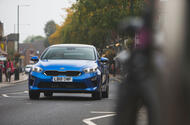 The latest Ceed is the best yet. But is it now good enough to be a real contender?
The latest Ceed is the best yet. But is it now good enough to be a real contender?
Why we’re running it: To see if the new, Europe-designed Ceed is a true Volkswagen Golf rival or still a bit of a family hatchback also-ran
Month 5 - Month 4 - Month 3 - Month 2 - Month 1 - Prices and specs
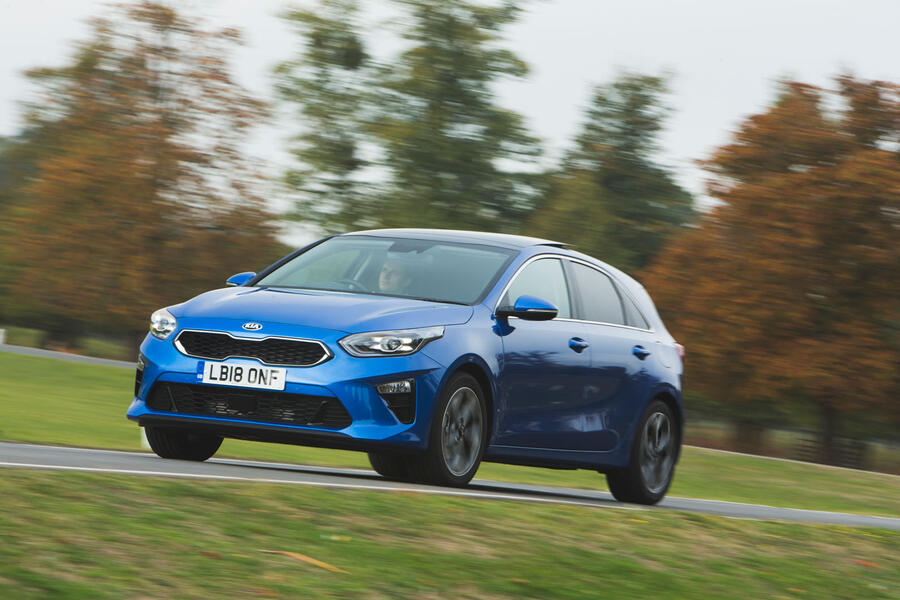
Life with a Kia Ceed: Month 5
Three different models in six months gave us valuable insights into why you might – or might not – want to buy a Ceed - 1st May 2018
We all like a bit of surprise and delight in new cars. Whether it’s a dazzling new feature, clever bit of tech or sumptuous materials, sometimes a bit of ‘wow’ factor is worth the expense.
But for some, of greater importance when buying a model is the knowledge that whatever situation you throw it into, it can handle it with the minimum of drama and fuss. Something that just works – no foibles, no aggravation, no distractions. Something like the new, third-generation Kia Ceed.
During the past six months, I have become intimately familiar with the Ceed range as a whole, not just one specific model. I was spoiled with luxuries hardly befitting a humble family hatch with a top-spec First Edition model, before going utilitarian and swapping that for the other end of the spectrum: the base 1.0-litre petrol in entry-level 2 trim.
Originally, that second car was meant to last me until the end of March, but it was not to be. During a weekend of healthy snowfall and ice build-up, the need to take evasive action to avoid an out-of-control Audi Q5 coming around a bend over the white line put the Ceed into a frustrating, unavoidable low-speed trajectory off the road into a ditch.
When Kia took it back for repairs and said we’d be unable to get an identical-spec car to replace it in time to complete our test, we thought we’d try the only non-performance engine left in the line-up: the 1.6-litre diesel.
That has almost become a bit of a dirty word in recent years, hasn’t it? Knee-jerk government reactions to concern over local pollutants (not really a problem with the latest EU6d temp cars) mean this engine no longer takes the lion’s share of Ceed sales. But should that be the case?
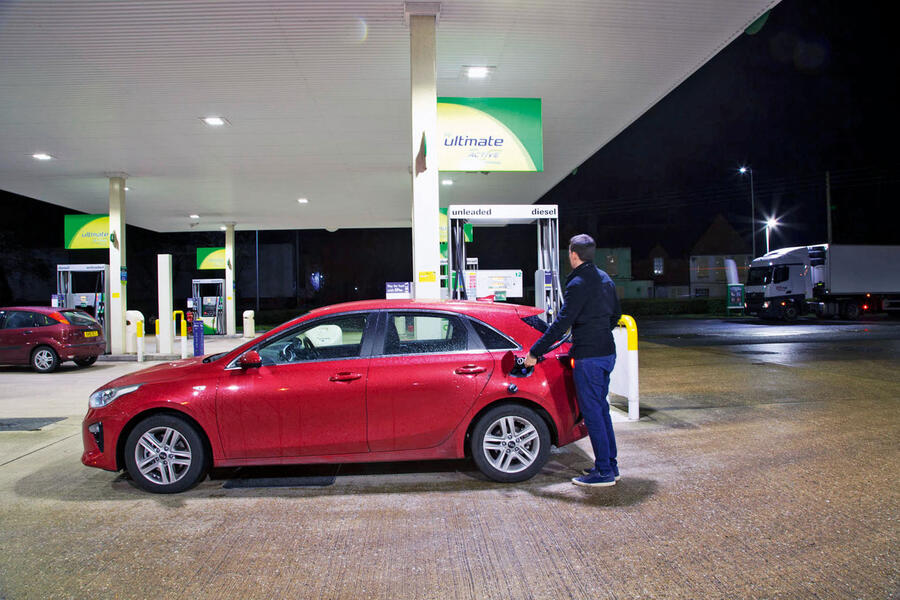
Our lower-powered 1.6-litre diesel is around £1200 pricier than the identical-spec 1.0 that met a fateful end in February. That’s a fair sum for something that is no faster on paper and needs to be filled with fuel that’s currently 10 pence a litre pricier. But factor in that the diesel has proven to be a healthy 15-20mpg more economical on the same journeys and, given my annual mileage, it’s still the rational (if not the emotional) choice.
It also feels faster thanks to 207lb ft of torque (versus 127lb ft for the 1.0). Refinement is decent once the motor has warmed up, although I do miss the three-cylinder petrol motor’s willing thrum. However, there are a couple of reasons why you might not choose the diesel.
The first is the long, economy-biased gearing that admittedly helps it to be one of the most frugal real-world cars around, as it sits at barely over 2000rpm at 70mph. My commute involves a fair bit of 30mph driving and, in fourth, the revs are too low to be comfortable at that speed. You can drive around that, of course, but the trait you can’t drive around is the extra weight over the nose. It’s still a tidy handler, but the diesel loses some of the petrol’s fleetfootedness and the steering feels less positive on turn-in.
What the Ceed has always been, regardless of spec, is a tremendously fuss-free and welcoming place to sit after a long day in the office. Kia hasn’t succumbed to the style-over-substance cabin design favoured by a number of rivals (PSA, we’re looking at you), which is just fine by me: the touchscreen isn’t the dominant control point and switchgear placement is so logical that you genuinely never need to take your eyes off the wheel. My stress levels benefited from that.
Other ways the Ceed was quietly excellent? The ride smoothness brought about by the base model’s 16in wheels was very welcome on the cratered, post-winter roads. It also meant no cabin rattles (unlike the bigger-wheeled First Edition).
The Ceed has more than proven itself as a practical offering. A recent airport trip for a holiday loaded it up with four six-footers, each carrying two weeks’ worth of luggage, with which the Kia was just about able to cope thanks to one of the most usable boots in its class. Drop the false floor and four decent-sized suitcases can be squeezed in with a healthy shove of the tailgate to get it closed. On another occasion, I was able (with a bit of trimming) to squeeze an old memory foam mattress into the back with the seats folded flat. All this and yet Kia still manages to do what many others don’t and fit a spare wheel in the back. Little things.

If I could criticise the Kia, it’s that there’s little to get excited about. It’s a very competent drive but never something you relish getting behind the wheel of (particularly in diesel form). The design is smart and nicely resolved, but not one of Peter Schreyer’s boldest efforts. And none of the powertrains is notable for being anything other than quite smooth and acceptably powerful.
It’s clear that Kia benchmarked the Volkswagen Golf with this car: it’s similarly well rounded and well thought through, but just as unlikely to thrill or intrigue. What’s great about the Kia, though, is that it does 95% of what a Golf can do for a chunk less cash, and with more standard equipment. We know Kia can do value but, with this generation of Ceed, we also know it can do simplicity, smartness and solidity.
Second Opinion
Before I had a chance to try the regular Ceed, the sporty Proceed really impressed me in how it drove. And while this hatchback long-term car was of the most basic spec, traces of that neat handling and tied-down ride promise were evident. I much preferred the Proceed’s turbo petrol engine to this diesel, though.
Kris Culmer
Love it:
Economy Struggled to get to 45mpg in the 1.0 petrol, so an easy 65mpg at a cruise from the diesel was welcome.
Comfort Wheels might give away its entrylevel spec, but the chunky sidewall smooths out the low-speed ride.
Cabin Not groundbreaking but a haven of intuitive switchgear and the driving position is tremendously comfy.
Loathe it:
Styling Without the First Edition’s fancy lights and bright blue paint, the basespec car looks a bit anonymous.
Blunted by a full load Not a ‘loathe’, but loading up with luggage and passengers exposed our 1.6 diesel’s modest output.
Final mileage: 2800

Life with a Kia Ceed: Month 4
More bad news - 6th March 2019
My Ceed has been in the wars again – but this time, it was more serious. Driving in the aftermath of a heavy snowfall, I was forced to take evasive action when an Audi Q5 rounded a bend over the white line, resulting in a ruined front bumper. While it’s being fixed, Kia has replaced the 1.0 petrol with a 1.6 diesel, which should put to bed any fuel economy concerns.
Mileage: 2270
Windscreen repair required - 6th February 2019
Typical. Picked up a big stone chip on the Thursday, and all it had to do was last until Saturday so I could get it filled. Then, after blasting the heater at the screen on Friday morning, it cracked right across the driver’s side view. My fault, I know, but at least Autoglass will come to your place of work. Maybe that smooth, polished new screen might help with the 1.0’s underwhelming fuel economy…
Mileage: 2682

Life with a Kia Ceed: Month 3
We’ve traded a top-spec one for the entry model. Any regrets? - 23rd January 2019
Do you know anyone who has bought an entry-level car in recent years?
I don’t. Such is the culture of easy sell-ups and tempting lease deals, it’s usually a no-brainer to pay an often heavily discounted sum to upgrade.
In fact, some manufacturers have actively removed the lowest rung on their trim level ladder due to lack of interest. But should you always spend more to get extra equipment you may never use?
That’s what I’ll establish as I take custody of the cheapest Kia Ceed you can buy new.
Last September, I started running the premium-brand-baiting 1.4-litre First Edition Ceed. For the princely sum of just under £27,000, you get, as I’ve outlined in previous reports, a staggering array of kit for a family hatchback.
But while it was all very nice, I knew that if it was my miraculously earned £27k, I’d want something with a darn sight more than 138bhp. So with a desire to explore just how broad the Ceed’s appeal could be, I went to the other end of the range spectrum – the same spec of Ceed that we compared it with in November last year.
And it seems that Kia has joined the ranks by axing its true base model, with no 1-trim variant for this generation. That means the price jumps by around £3000 to this 2 spec – steep in isolation but in line with where rivals begin now. A quick comparison of contract hire deals shows a saving of around £70 per month by going for the base model.
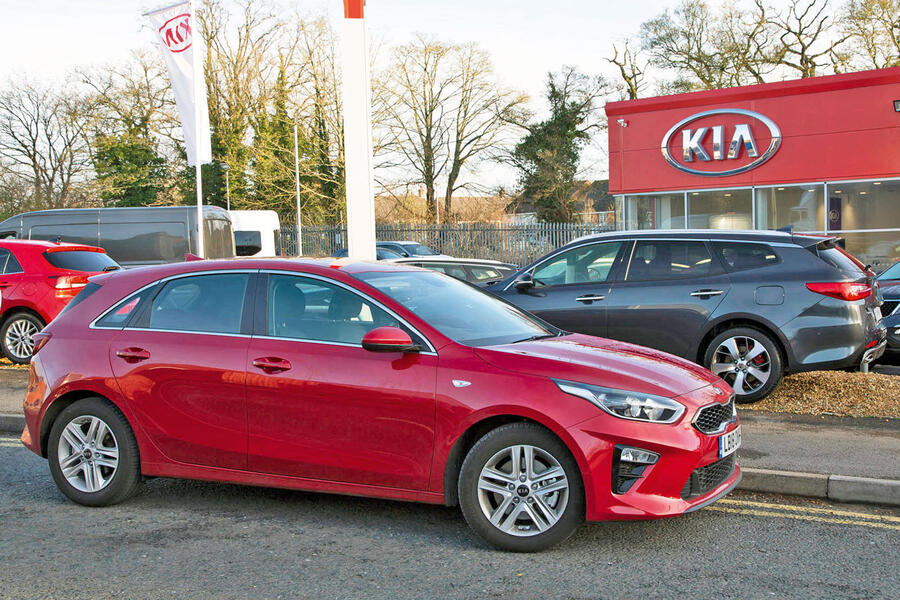
Unsurprisingly, given the price jump, it doesn’t feel like a base model. You still get a touchscreen with Android Auto and Apple CarPlay (you don’t in a base Ford Focus), cruise control of the non-adaptive variety (which I actually prefer) and lane keep assist (which is turned off immediately on start-up). Heck, there’s even a standard spare wheel – a rarity these days.
You also get more power than you might expect. Whereas a similarly priced Focus or Vauxhall Astra will be lumbered with a sub-100bhp motor, the Ceed 1.0-litre triple makes a healthier 118bhp. For comparison, my old 1.4 had 15% more power for more than £8000 extra.
However, this 1.0 doesn’t have as punchy a mid-range as the very best turbo triples. It needs some revs, both to get it off the line smoothly and to get up to speed.
Fuel economy seems barely better than with the 1.4 on first impressions, with an average of around 45mpg on my gentle commute – reasonable, but not remarkable. The current average is the result of a number of town trips over the Christmas holidays, but I reckon this is one of those cases where a relatively heavy car gives a small-capacity engine a harder time when keeping pace at higher speeds.
With just under 1000 miles covered upon delivery, this engine may loosen up over time, but currently it seems I’ll be mourning the 1.4’s greater balance of power and economy. I won’t be missing that car’s larger wheels, though. As I mentioned in November, the more modest 16in items on this car benefit both ride compliance and road noise.
The cheapest Ceed also still gets the costlier multi-link rear suspension: editor Mark Tisshaw’s £28,000 Mercedes A-Class makes do with a cheaper, simpler torsion beam set-up. I may be missing some features, but so far it seems like this base model isn’t one you need to avoid.
Love it:
VALUE FOR MONEY It’s pricier than the old Ceed but this spec still looks good value next to entry-level rivals, with more kit and performance than most.
Loathe it:
BLUNTED PERFORMANCE Not ‘loathe’ exactly, but the engine’s performance isn’t as sprightly as we’re used to with the best three-cylinder turbos.

A few negatives, but only if you’re picky - 2nd January 2018
Recently, I succeeded at eliminating a pesky rattle in the Ceed’s roof headlining with a piece of carpet underlay and a Phillips screwdriver. Great. But now I can’t stop noticing how the keyfob buzzes in its little slot in the centre console, a foible shared with most cars with keyless start. Notice how I’m nitpicking? Truth is, the Kia is a thoroughly complete car that’s very difficult to fault.
Mileage: 3478

Life with a Kia Ceed: Month 2
Buttons are a blessing - 28 November 2018
Late-night airport runs leave me tired, stressed and susceptible to being easily wound up. Thankfully, the Ceed has this uncanny ability to relax you with its cabin’s ease of use. Simple tasks like turning lane keep assist off, changing media sources and dimming instrument backlights can be done in a split second with old-school physical buttons.
Mileage: 2817

Is our top-spec car really £8k better than the entry-level one? - 14 November 2018
Really? £27,000? You can get an [insert supposedly more premium rival here] for that!” It’s a phrase I’ve heard more than once when people ask about the top-spec Kia Ceed I’m running. It’s a fair point when you think that £27k will very nearly get you into a base Audi A4.
My stock advice is that more modest trim levels better balance necessary equipment and list price. But it’s not a view shared by buyers. Manufacturers are increasingly finding that the higher trim levels are the most popular choice, particularly when packaged into a PCP deal.
As luck would have it, we had an entry-level Ceed in for a separate test, so I leapt at the chance to get them together and see if my First Edition spec could justify its £8000 premium. First off, let’s look at appearance, inside and out. The Ceed isn’t the most attention-grabbing hatch, but it majors on classy understatement.
The entry-level car obviously retains the same basic shape, but a few key design elements are missing.
For example, it has the same LED running lights as the top-spec car but ditches the full LED headlights in favour of less premium-looking halogen bulbs. The door mirrors, as well as losing their auto-folding mechanism, ditch the LED indicators and puddle lights of the range-topper. The wheels are an inch smaller, too, and there’s no privacy glass.
Nothing dramatic, then, but the changes are enough to give the Ceed less kerb appeal, to my eyes. But it’s the interiors that most set the two trims apart – not just the way they look but also the way they feel. Soft leather upholstery, padded door inserts and glossy plastics are replaced by a notably less tactile and more austere environment. Little details make all the difference here, too, such as the cool white LED interior lighting of my car swapped for dull yellow bulbs.
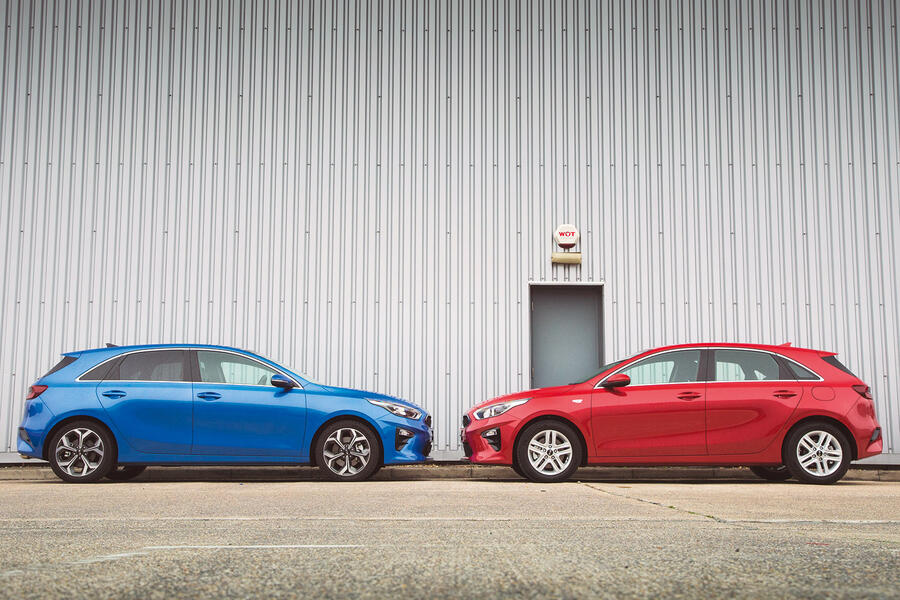
Of course, my Ceed has far more standard kit, but the base Ceed isn’t totally spartan. There’s still a touchscreen (albeit with an inch lopped off the display and no satnav), cruise control, DAB and a rear-view camera, but the seats have manual adjustment and the air-con isn’t automatic. For reliable, simple transport, it’s utterly fit for purpose. The differences on the road are perhaps more surprising.
It’s the cheaper Ceed that’s more comfortable overall, with the extra inch of tyre sidewall allowing for greater bump absorption at lower speeds and less road noise.
Whether you prefer the reasonably slick manual shift or the largely smooth seven-speed automatic is personal taste, but the greater degree of control (coupled with the lack of paddle shifters for the auto ’box) sways me towards the manual option. The First Edition’s four-cylinder motor doesn’t have the all-round refinement advantage over the base 1.0-litre three pot you might expect, either. Sure, at lower revs, the fourpot is arguably less intrusive and smoother, but the reverse is true at high revs, where the 1.4-litre engine becomes coarse.
Of course, the 1.4-litre offers more power and, crucially, more low-down torque, feeling more muscular in the process. The 1.0-litre needs to be worked a fair bit harder in the same situations, meaning that it was only around 5mpg more economical over the same journey.
Overall, although I prefer the added luxury and performance of my top-spec Ceed, it would have to be seriously tempting on a monthly payment basis for me to justify the 40% price jump.
Love it:
Upmarket feel inside First Edition spec brings a cabin that looks premium enough to take on the German establishment.
Loathe it:
Noises off The firm edge to the ride is exacerbating an annoying clicking noise behind the roof headlining.
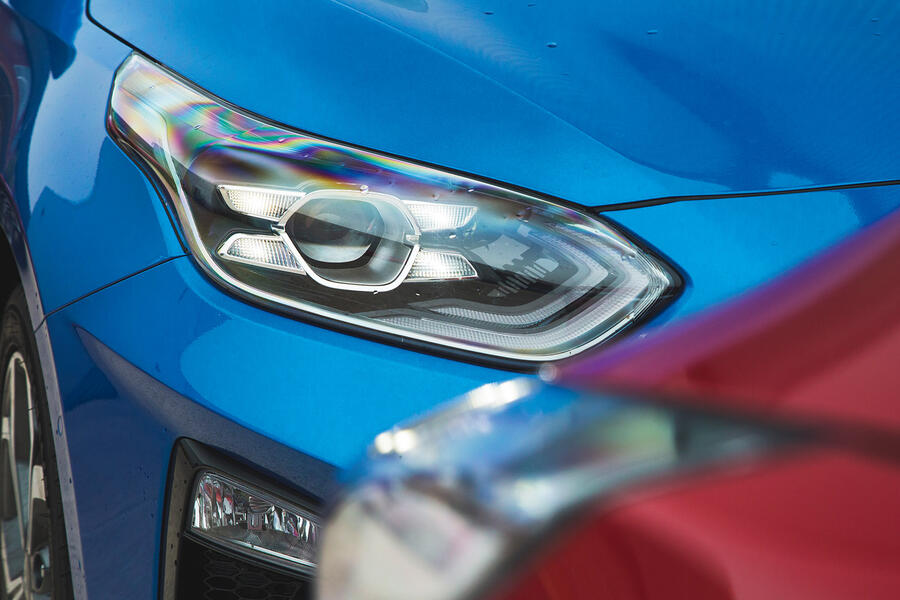
Mileage: 2420
Life with a Kia Ceed: Month 1
Ceed sees its first cold weather - 31 October 2018
Mid-October saw the first morning commute start with ice covering the Ceed’s windscreen. Our top-spec car comes with heated seats (great) and a heated steering wheel (even better) but no heated front screen. In an ideal world, I’d sacrifice the passenger seat heater to have the screen clear quickly, because I’m selfish like that.
Mileage: 2019

Welcoming the Ceed to the fleet - 17th October 2018
Crossovers might be increasingly dominant in the family car sales charts, but hatchbacks remain the bread and butter of many car makers’ ranges. Cars such as the Ford Focus and Volkswagen Golf are of vital importance to the industry and buyers alike, as reflected in the billions of pounds spent on the development and marketing of them.
New entrants to the market often have a difficult time establishing themselves and the previous two generations of the Kia Ceed – despite being perfectly competent – took time to make the necessary dent in the more established competition.
But Kia’s determination to crack the European hatch market has resulted in a C-segment car that is now designed in Europe, built in Europe and will be sold exclusively in Europe. So we’re running one for a few months to see, first, if it feels like a true European hatchback and, second, if such a car should still have a place in buyers’ minds alongside the ever-growing menagerie of crossovers and SUVs.
Well, our esteemed road testers think that the new Ceed has “fulfilled its potential” in this generation, making it “more worthy of recommendation than all but the very best cars in one of the toughest market segments in the world”. Who am I to disagree?
Exterior impressions, however, don’t seem to paint our Ceed as a particularly revolutionary car. With design head Peter Schreyer’s influence from his time at the Volkswagen Group, the Ceed appears to just about toe the line between the understated class of a Golf and complete anonymity. Despite this, it does seem to attract looks from passers-by – although that could be largely down to our car’s lovely Blue Flame paint. The subtle bodykit and 17in alloy wheels add a touch of visual appeal too.
We’ve opted for the top-spec First Edition model, which looks steep at a smidgen under £27,000 but is loaded to the gills with toys. The kit tally includes LED headlights, a large electric sunroof, a JBL sound system, smart park assist with front and rear sensors, an 8.0in touchscreen sat-nav and smart cruise control. There’s also an impressive array of other driver assist aids, which I’ll report on in detail once I’ve used them more.
What does mark the Ceed out are its fronts seats, which are not only electric and heated (the rears are heated too) but also ventilated – something usually found in only high-end models. A heated steering wheel should also ensure gloves won’t be needed when the weather turns bitter.
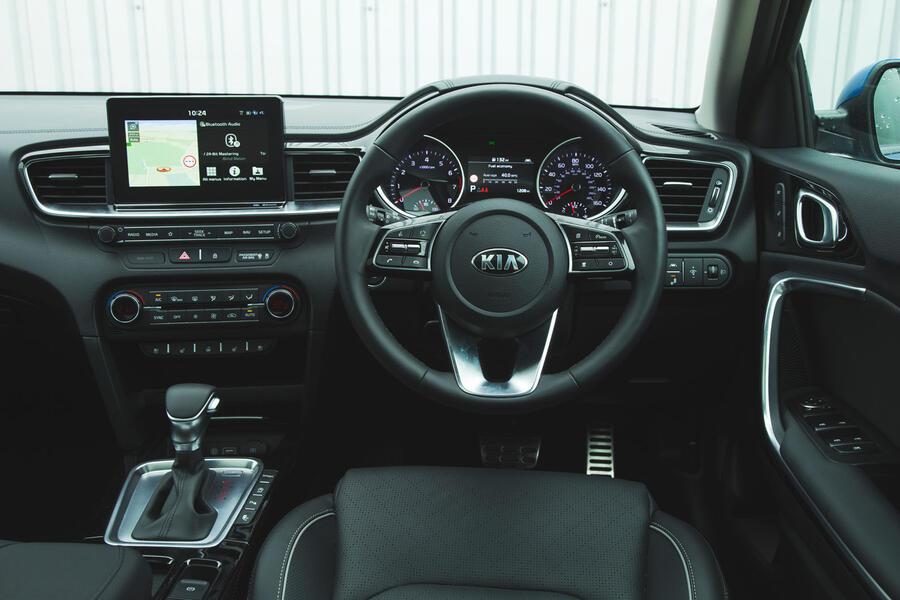
The interior overall stands out not just because of the kit but also the quality. This is as close to a Golf as Kia has ever been, with glossy or soft-touch plastic that’s pleasing to the eyes and touch, an attractive design and neat extras, such as the wireless phone charger under the centre stack.
Little touch points also show the effort Kia has made to improve perceived fit and finish, including the sliding cover for the USB and 12V points in the dashboard, which is so nicely damped that it wouldn’t be out of place in a Mercedes-Benz S-Class.
The only thing that’s taking the shine off so far is the passenger’s grab handle, which has started to rattle over bumps. I’ve yet to trouble the Ceed’s rear-seat room or boot space, but both appear generous enough for family life or a light weekend away.
Our Ceed isn’t just fully loaded in terms of trim: it also has the most powerful engine available at launch (before the Ceed GT arrives). The 1.4-litre turbo petrol four-pot pumps out a modest 138bhp but a healthy 178lb ft of torque, and is mated to Kia’s seven-speed dual-clutch gearbox.
With less than 1000 miles on the clock, it’s barely run in, but performance is little more than adequate. The 0-62mph dash takes 8.9sec, which is unremarkable for a top-flight engine, and that’s how it seems on the road. It feels punchy and smooth after an initial throttle deadness, which eggs you on to start extending it, but above 4000rpm, all you get is a rather coarse engine note without much additional oomph. At least it’s impressively refined when taking it easy, where the dual-clutch ’box is better at timing and dampening its gearshifts.
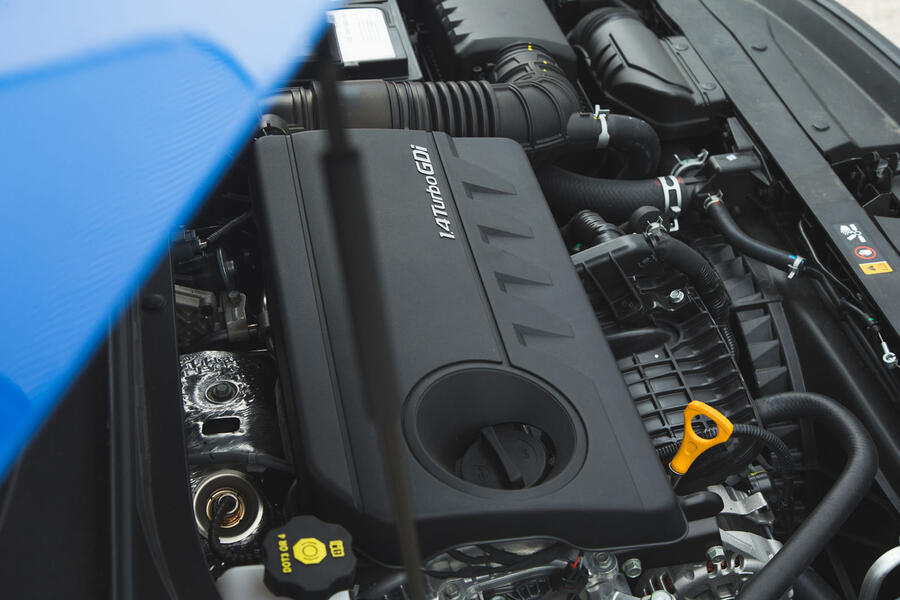
It’s a pity the engine is merely average because the Ceed is a surprisingly agile and composed steer, based on first impressions. The taut chassis set-up means body control is tight and the steering perfectly balances directness and high-speed stability. One trade-off for this is that the ride is a little firmer around town than it should be, although it’s still an improvement on the outgoing Ceed in that respect.
Minor gripes aside, the initial outlook is positive for our EuroKorean hatch. Even fuel economy is better than expected, as I’m averaging 43mpg on mixed town and motorway work without really trying. We’ll see over the next few months if the Ceed can offer the ownership proposition of the class’s big hitters.
Second Opinion
There’s no doubt that the new Ceed is one of the more inspiring hatchbacks to drive, but I still think Kia hasn’t got the ride quite right. There’s a nervous fidget that never really settles – and our car’s 17in alloy wheels aren’t exactly oversized.
Jimi Beckwith
Kia Ceed 1.4 T- GDI First Edition DCT prices and specification
Prices: List price new £19,850 List price now £19,850 Price as tested £19,850 Dealer value now £15,130 Private value now £14,455 Trade value now £13,760 (part exchange)
Options:none
Fuel consumption and range: Claimed economy 58.9mpg Fuel tank 50 litres Test average 61.4mpg Test best 64.2mpg Test worst 57.5mpg Real-world range 665 miles
Tech highlights: 0-62mph 10.6sec Top speed 116mph Engine 4 cylinder, 1598cc, diesel Max power 114bhp at 4000rpm Max torque 207 lb ft at 1500rpm Transmission 6-speed manual Boot capacity 380 litres Wheels 16in, alloy Tyres 205/55 R16 Kerb weight 1388kg
Service and running costs: Contract hire rate £190 CO2 99g/km Service costs none Other costs none Fuel costs £176 Running costs inc fuel £176 Cost per mile 9.6 pence Depreciation £6500 Cost per mile inc dep’n 46.6 Faults none

via Autobuzz Today
Comments
Post a Comment